page 92 MITSUBISHI ECLIPSE CROSS 2018 Owner's Manual (in English)
[x] Cancel search | Manufacturer: MITSUBISHI, Model Year: 2018, Model line: ECLIPSE CROSS, Model: MITSUBISHI ECLIPSE CROSS 2018Pages: 417, PDF Size: 74.06 MB
Page 373 of 417
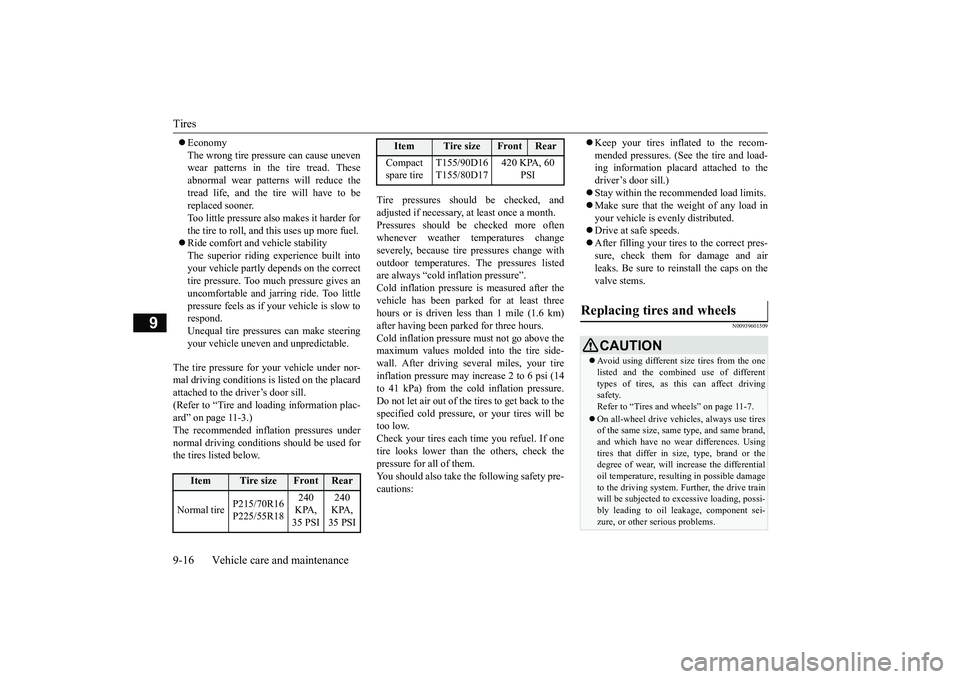
Tires 9-16 Vehicle care and maintenance
9
Economy The wrong tire pressure can cause uneven wear patterns in the tire tread. These abnormal wear patterns will reduce thetread life, and the tire will have to be replaced sooner. Too little pressure also makes it harder forthe tire to roll, and this uses up more fuel. Ride comfort and vehicle stability The superior riding experience built intoyour vehicle partly depends on the correcttire pressure. Too much pressure gives an uncomfortable and jarring ride. Too little pressure feels as if your vehicle is slow torespond. Unequal tire pressures can make steering your vehicle uneven and unpredictable.
The tire pressure for your vehicle under nor- mal driving conditions is listed on the placard attached to the driver’s door sill. (Refer to “Tire and loading information plac-ard” on page 11-3.) The recommended infl
ation pressures under
normal driving conditions should be used forthe tires listed below.
Tire pressures should be checked, and adjusted if necessary, at least once a month. Pressures should be checked more often whenever weather temperatures changeseverely, because tire pressures change with outdoor temperatures. The pressures listed are always “cold inflation pressure”.Cold inflation pressure is measured after the vehicle has been parked for at least three hours or is driven less than 1 mile (1.6 km)after having been parked for three hours.Cold inflation pressure must not go above the maximum values molded into the tire side- wall. After driving several miles, your tireinflation pressure may increase 2 to 6 psi (14 to 41 kPa) from the cold inflation pressure. Do not let air out of the tires to get back to thespecified cold pressure, or your tires will be too low. Check your tires each time you refuel. If onetire looks lower than the others, check the pressure for all of them. You should also take the following safety pre-cautions:
Keep your tires inflated to the recom- mended pressures. (See the tire and load- ing information placard attached to the driver’s door sill.) Stay within the recommended load limits. Make sure that the weight of any load in your vehicle is evenly distributed. Drive at safe speeds. After filling your tires to the correct pres- sure, check them for damage and airleaks. Be sure to reinstall the caps on thevalve stems.
N00939601509
Item
Tire size
Front
Rear
Normal tire
P215/70R16 P225/55R18
240 KPA, 35 PSI
240 KPA, 35 PSI
Compact spare tire
T155/90D16 T155/80D17
420 KPA, 60
PSI
Item
Tire size
Front
Rear
Replacing tires and wheels
CAUTION Avoid using different si
ze tires from the one
listed and the combined use of different types of tires, as this can affect drivingsafety. Refer to “Tires and wheels” on page 11-7. On all-wheel drive vehicles, always use tires of the same size, same type, and same brand, and which have no wear differences. Usingtires that differ in size, type, brand or the degree of wear, will increase the differential oil temperature, resulting in possible damage to the driving system. Further, the drive train will be subjected to excessive loading, possi-bly leading to oil leakage, component sei- zure, or other serious problems.
BK0252700US.bo
ok 16 ページ 2017年10月4日 水曜日 午後4時54分
Page 374 of 417
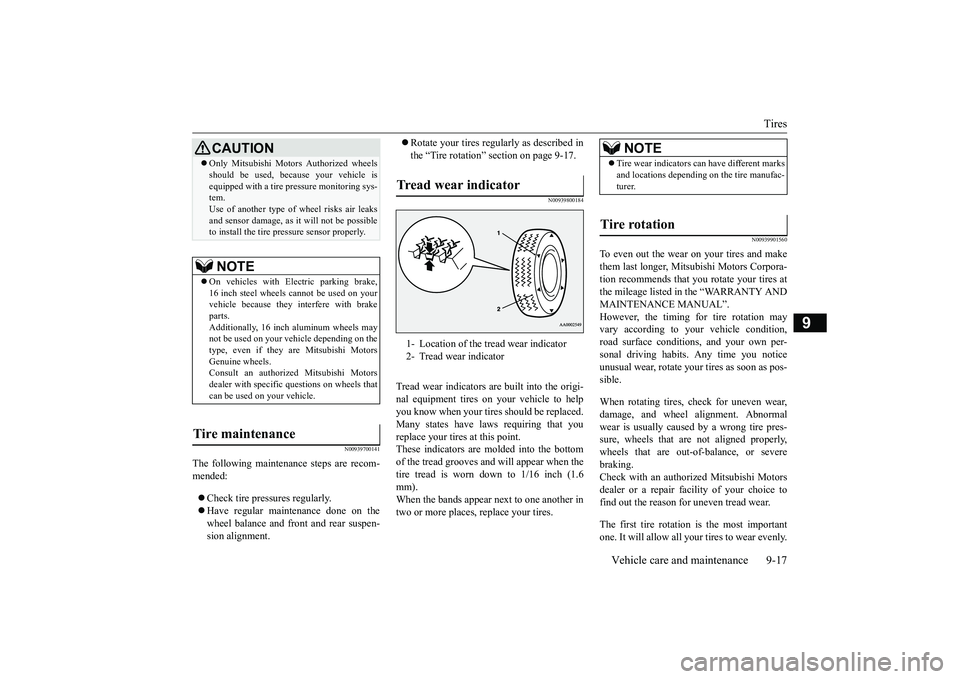
Tires
Vehicle care and maintenance 9-17
9
N00939700141
The following maintenance steps are recom- mended: Check tire pressures regularly. Have regular maintenance done on the wheel balance and front and rear suspen-sion alignment.
Rotate your tires regularly as described in the “Tire rotation” section on page 9-17.
N00939800184
Tread wear indicators are built into the origi- nal equipment tires on your vehicle to help you know when your tires should be replaced.Many states have laws requiring that you replace your tires at this point. These indicators are molded into the bottomof the tread grooves and will appear when the tire tread is worn down to 1/16 inch (1.6 mm).When the bands appear next to one another in two or more places, replace your tires.
N00939901560
To even out the wear on your tires and make them last longer, Mitsubishi Motors Corpora-tion recommends that you rotate your tires at the mileage listed in the “WARRANTY AND MAINTENANCE MANUAL”.However, the timing for tire rotation may vary according to your vehicle condition, road surface conditions, and your own per-sonal driving habits. Any time you notice unusual wear, rotate your tires as soon as pos- sible. When rotating tires, check for uneven wear, damage, and wheel alignment. Abnormal wear is usually caused by a wrong tire pres- sure, wheels that are not aligned properly,wheels that are out-of-balance, or severe braking. Check with an authorized Mitsubishi Motorsdealer or a repair faci
lity of your choice to
find out the reason for uneven tread wear. The first tire rotation is the most important one. It will allow all your tires to wear evenly.
Only Mitsubishi Motors Authorized wheels should be used, because your vehicle is equipped with a tire pressure monitoring sys- tem. Use of another type of wheel risks air leaksand sensor damage, as it will not be possible to install the tire pressure sensor properly.NOTE
On vehicles with Electric parking brake, 16 inch steel wheels cannot be used on yourvehicle because they interfere with brake parts. Additionally, 16 inch aluminum wheels maynot be used on your vehicle depending on the type, even if they are Mitsubishi Motors Genuine wheels.Consult an authorized Mitsubishi Motors dealer with specific questions on wheels that can be used on your vehicle.
Tire maintenance
CAUTION
Tread wear indicator 1- Location of the tread wear indicator 2- Tread wear indicator
NOTE
Tire wear indicators can have different marks and locations depending on the tire manufac- turer.
Tire rotation
BK0252700US.bo
ok 17 ページ 2017年10月4日 水曜日 午後4時54分
Page 376 of 417
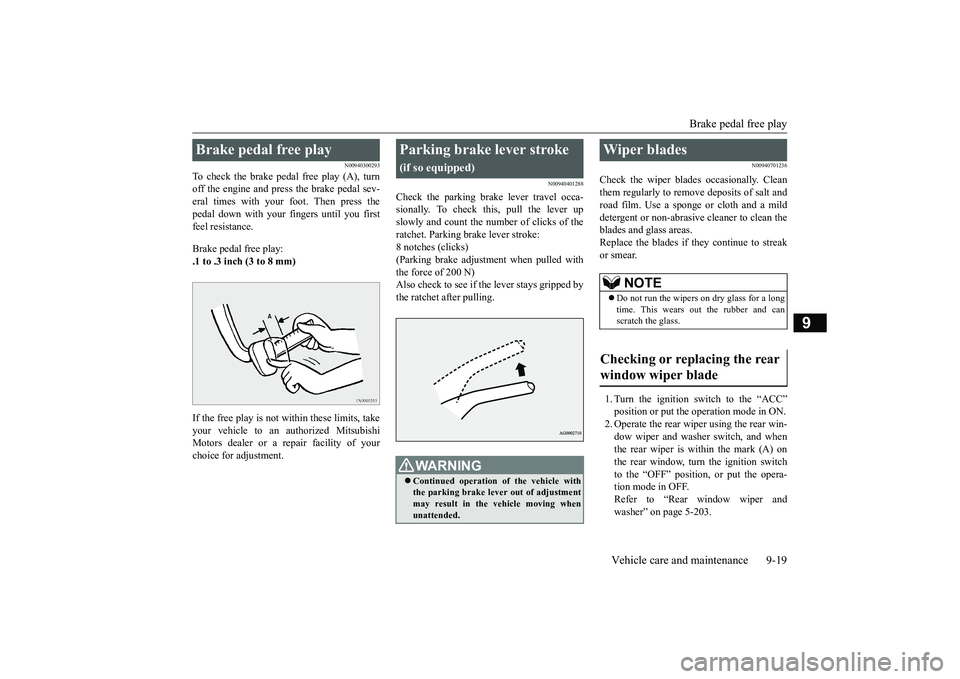
Brake pedal free play
Vehicle care and maintenance 9-19
9
N00940300293
To check the brake pedal free play (A), turn off the engine and press the brake pedal sev-eral times with your foot. Then press the pedal down with your fingers until you first feel resistance. Brake pedal free play: .1 to .3 inch (3 to 8 mm) If the free play is not within these limits, take your vehicle to an authorized Mitsubishi Motors dealer or a repair facility of your choice for adjustment.
N00940401288
Check the parking brake lever travel occa-sionally. To check this, pull the lever upslowly and count the number of clicks of the ratchet. Parking brake lever stroke: 8 notches (clicks)(Parking brake adjustment when pulled with the force of 200 N) Also check to see if the lever stays gripped bythe ratchet after pulling.
N00940701236
Check the wiper blades occasionally. Cleanthem regularly to remove deposits of salt androad film. Use a sponge or cloth and a mild detergent or non-abrasive cleaner to clean the blades and glass areas.Replace the blades if they continue to streak or smear. 1. Turn the ignition switch to the “ACC” position or put the operation mode in ON. 2. Operate the rear wiper using the rear win-dow wiper and washer switch, and when the rear wiper is within the mark (A) on the rear window, turn the ignition switchto the “OFF” position,
or put the opera-
tion mode in OFF. Refer to “Rear window wiper andwasher” on page 5-203.
Brake pedal free play
Parking brake lever stroke
(if so equipped)
WA R N I N G Continued operation of the vehicle with the parking brake lever out of adjustment may result in the vehicle moving when unattended.
Wiper blades
NOTE
Do not run the wipers on dry glass for a long time. This wears out the rubber and can scratch the glass.
Checking or replacing the rear window wiper blade
BK0252700US.bo
ok 19 ページ 2017年10月4日 水曜日 午後4時54分
Page 377 of 417
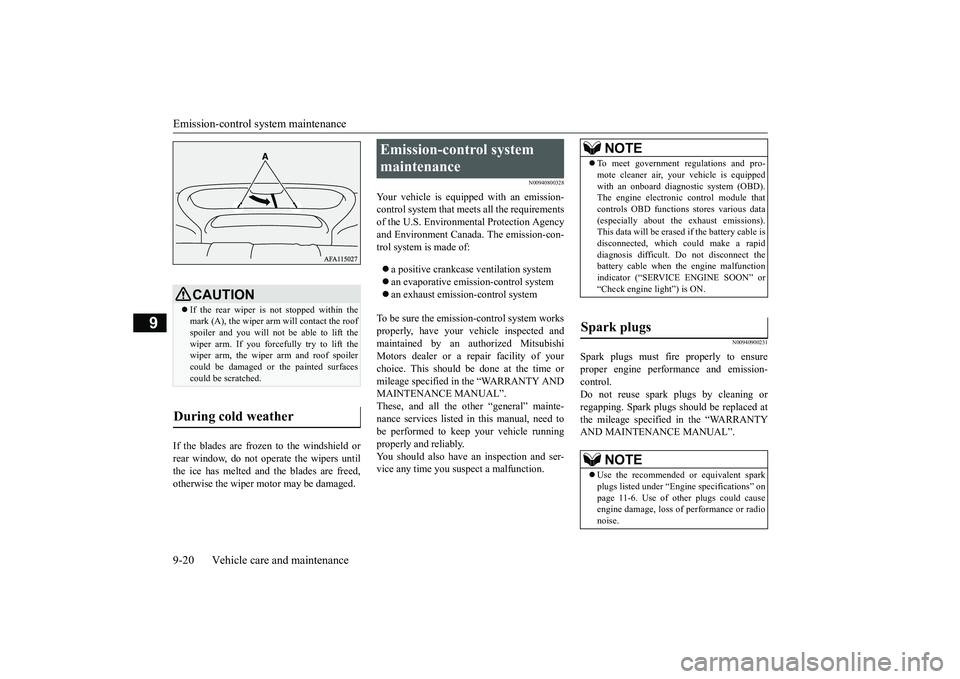
Emission-control system maintenance 9-20 Vehicle care and maintenance
9
If the blades are frozen to the windshield or rear window, do not operate the wipers until the ice has melted and the blades are freed,otherwise the wiper motor may be damaged.
N00940800328
Your vehicle is equipped with an emission-control system that meets all the requirementsof the U.S. Environmental Protection Agency and Environment Canada. The emission-con- trol system is made of: a positive crankcase ventilation system an evaporative emission-control system an exhaust emission-control system
To be sure the emission-control system works properly, have your vehicle inspected and maintained by an authorized MitsubishiMotors dealer or a repair facility of your choice. This should be done at the time or mileage specified in the “WARRANTY ANDMAINTENANCE MANUAL”. These, and all the other “general” mainte- nance services listed in this manual, need tobe performed to keep your vehicle running properly and reliably. You should also have an inspection and ser-vice any time you suspect a malfunction.
N00940900231
Spark plugs must fire properly to ensureproper engine performance and emission-control. Do not reuse spark plugs by cleaning or regapping. Spark plugs should be replaced atthe mileage specified in the “WARRANTY AND MAINTENANCE MANUAL”.
CAUTION If the rear wiper is not stopped within the mark (A), the wiper arm will contact the roofspoiler and you will not be able to lift the wiper arm. If you forcefully try to lift the wiper arm, the wiper arm and roof spoilercould be damaged or the painted surfaces could be scratched.
During cold weather
Emission-control system maintenance
NOTE
To meet government regulations and pro- mote cleaner air, your vehicle is equipped with an onboard diagnostic system (OBD). The engine electronic control module that controls OBD functions stores various data(especially about the exhaust emissions). This data will be erased if the battery cable is disconnected, which could make a rapiddiagnosis difficult. Do not disconnect the battery cable when the engine malfunction indicator (“SERVICE ENGINE SOON” or“Check engine light”) is ON.
Spark plugs
NOTE
Use the recommended or equivalent spark plugs listed under “Engine specifications” on page 11-6. Use of other plugs could cause engine damage, loss of performance or radionoise.
BK0252700US.bo
ok 20 ページ 2017年10月4日 水曜日 午後4時54分
Page 378 of 417
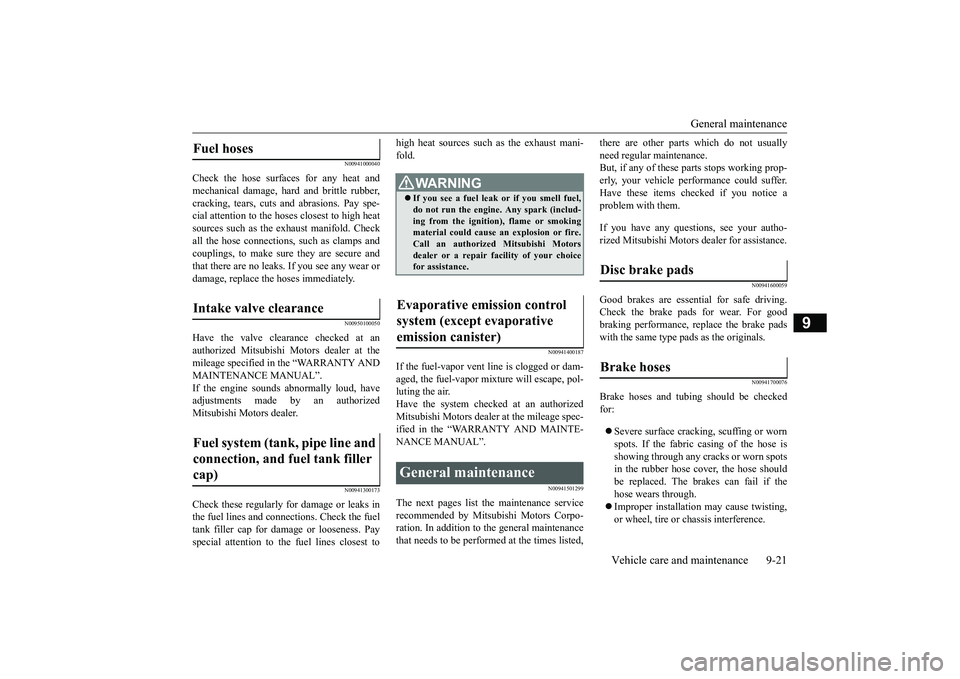
General maintenance
Vehicle care and maintenance 9-21
9
N00941000040
Check the hose surfaces for any heat and mechanical damage, hard and brittle rubber,cracking, tears, cuts and abrasions. Pay spe- cial attention to the hoses closest to high heat sources such as the exhaust manifold. Checkall the hose connections, such as clamps and couplings, to make sure they are secure and that there are no leaks. If you see any wear ordamage, replace the hoses immediately.
N00950100050
Have the valve clearance checked at anauthorized Mitsubishi Motors dealer at themileage specified in the “WARRANTY AND MAINTENANCE MANUAL”. If the engine sounds abnormally loud, haveadjustments made by an authorized Mitsubishi Motors dealer.
N00941300173
Check these regularly for damage or leaks in the fuel lines and connections. Check the fuel tank filler cap for damage or looseness. Pay special attention to the fuel lines closest to
high heat sources such as the exhaust mani- fold.
N00941400187
If the fuel-vapor vent line is clogged or dam- aged, the fuel-vapor mixture will escape, pol- luting the air.Have the system checked at an authorized Mitsubishi Motors dealer at the mileage spec- ified in the “WARRANTY AND MAINTE-NANCE MANUAL”.
N00941501299
The next pages list the maintenance servicerecommended by Mitsubishi Motors Corpo- ration. In addition to the general maintenance that needs to be perfor
med at the times listed,
there are other parts which do not usually need regular maintenance. But, if any of these parts stops working prop- erly, your vehicle performance could suffer.Have these items checked if you notice a problem with them. If you have any questions, see your autho- rized Mitsubishi Motors
dealer for assistance.
N00941600059
Good brakes are essential for safe driving. Check the brake pads for wear. For good braking performance, replace the brake padswith the same type pads as the originals.
N00941700076
Brake hoses and tubing should be checkedfor: Severe surface cracking, scuffing or worn spots. If the fabric casing of the hose is showing through any cracks or worn spotsin the rubber hose cover, the hose should be replaced. The brakes can fail if the hose wears through. Improper installation may cause twisting, or wheel, tire or chassis interference.
Fuel hoses Intake valve clearance Fuel system (tank, pipe line and connection, and fuel tank filler cap)
WA R N I N G If you see a fuel leak or if you smell fuel, do not run the engine. Any spark (includ- ing from the ignition), flame or smokingmaterial could cause an explosion or fire. Call an authorized Mitsubishi Motors dealer or a repair facility of your choicefor assistance.
Evaporative emission control system (except evaporative emission canister) General maintenance
Disc brake pads Brake hoses
BK0252700US.bo
ok 21 ページ 2017年10月4日 水曜日 午後4時54分
Page 380 of 417
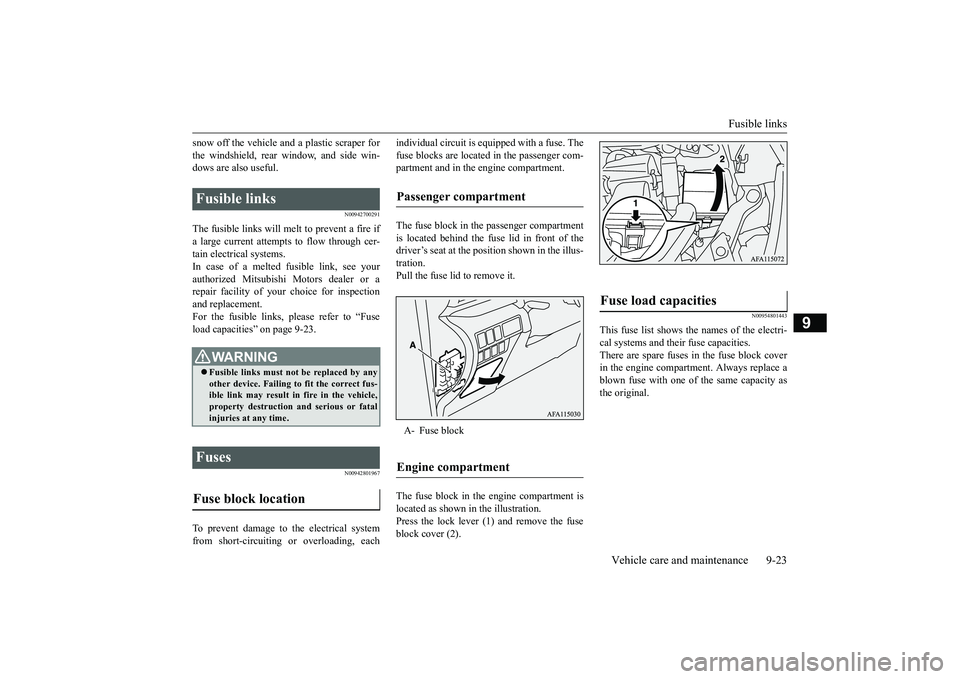
Fusible links
Vehicle care and maintenance 9-23
9
snow off the vehicle and a plastic scraper for the windshield, rear window, and side win- dows are also useful.
N00942700291
The fusible links will melt
to prevent a fire if
a large current attempts to flow through cer- tain electrical systems.In case of a melted fusible link, see yourauthorized Mitsubishi Motors dealer or a repair facility of your choice for inspection and replacement.For the fusible links, please refer to “Fuse load capacities” on page 9-23.
N00942801967
To prevent damage to the electrical system from short-circuiting or overloading, each
individual circuit is equipped with a fuse. The fuse blocks are located in the passenger com- partment and in the engine compartment. The fuse block in the passenger compartment is located behind the fuse lid in front of the driver’s seat at the position shown in the illus-tration.Pull the fuse lid to remove it. The fuse block in the engine compartment is located as shown in the illustration.Press the lock lever (1) and remove the fuse block cover (2).
N00954801443
This fuse list shows the names of the electri- cal systems and their fuse capacities. There are spare fuses in the fuse block cover in the engine compartment. Always replace ablown fuse with one of the same capacity asthe original.
Fusible links
WA R N I N G Fusible links must not be replaced by any other device. Failing to fit the correct fus-ible link may result in fire in the vehicle, property destruction and serious or fatal injuries at any time.
Fuses Fuse block location
Passenger compartment A- Fuse blockEngine compartment
Fuse load capacities
BK0252700US.bo
ok 23 ページ 2017年10月4日 水曜日 午後4時54分
Page 408 of 417
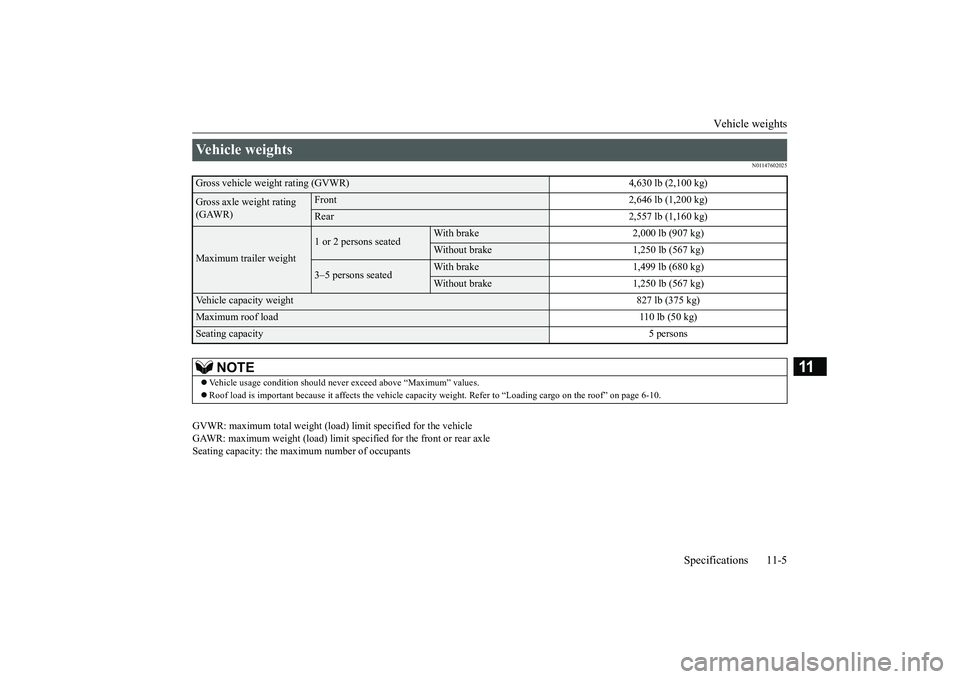
Vehicle weights
Specifications 11-5
11
N01147602025
GVWR: maximum total weight (load) limit specified for the vehicle GAWR: maximum weight (load) limit sp
ecified for the front or rear axle
Seating capacity: the maximum number of occupantsVehicle weights Gross vehicle weight rating (GVWR) 4,630 lb (2,100 kg)Gross axle weight rating (GAWR)
Front 2,646 lb (1,200 kg)Rear 2,557 lb (1,160 kg)
Maximum trailer weight
1 or 2 persons seated
With brake 2,000 lb (907 kg)Without brake 1,250 lb (567 kg)
3–5 persons seated
With brake 1,499 lb (680 kg)Without brake 1,250 lb (567 kg)
Vehicle capacity weight
827 lb (375 kg)
Maximum roof load
110 lb (50 kg)
Seating capacity
5 persons
NOTE
Vehicle usage condition should neve
r exceed above “Maximum” values.
Roof load is important because it affects the vehicle capac
ity weight. Refer to “Loading
cargo on the roof” on page 6-10.
BK0252700US.bo
ok 5 ページ 2017年10月4日 水曜日 午後4時54分
Page 410 of 417
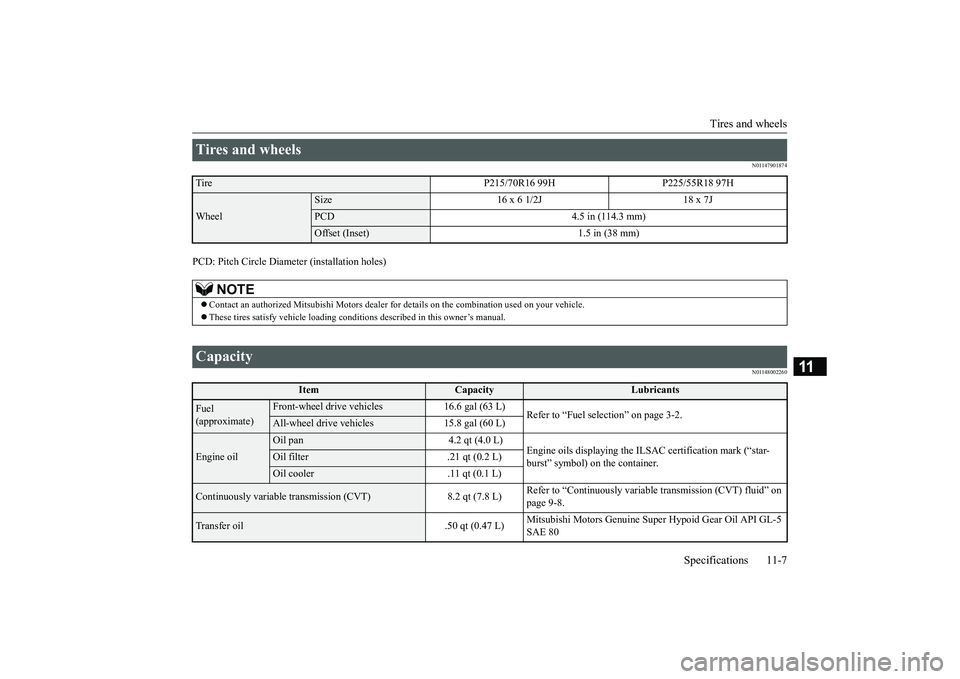
Tires and wheels
Specifications 11-7
11
N01147901874
PCD: Pitch Circle Diameter (installation holes)
N01148002260
Tires and wheels Tire P215/70R16 99H P225/55R18 97HWheel
Size 16 x 6 1/2J 18 x 7JPCD 4.5 in (114.3 mm)Offset (Inset) 1.5 in (38 mm)
NOTE
Contact an authorized Mitsubishi Motors dealer
for details on the combination used on your vehicle.
These tires satisfy vehicle loading cond
itions described in this owner’s manual.
Capacity
Item
Capacity
Lubricants
Fuel (approximate)
Front-wheel drive vehicles 16.6 gal (63 L)
Refer to “Fuel selection” on page 3-2.
All-wheel drive vehicles 15.8 gal (60 L)
Engine oil
Oil pan 4.2 qt (4.0 L)
Engine oils displaying the ILSAC certification mark (“star- burst” symbol) on the container.
Oil filter .21 qt (0.2 L)Oil cooler .11 qt (0.1 L)
Continuously variable transmission (CVT) 8.2 qt (7.8 L)
Refer to “Continuously variable transmission (CVT) fluid” on page 9-8.
Transfer oil .50 qt (0.47 L)
Mitsubishi Motors Genuine Super Hypoid Gear Oil API GL-5 SAE 80
BK0252700US.bo
ok 7 ページ 2017年10月4日 水曜日 午後4時54分
Page 411 of 417
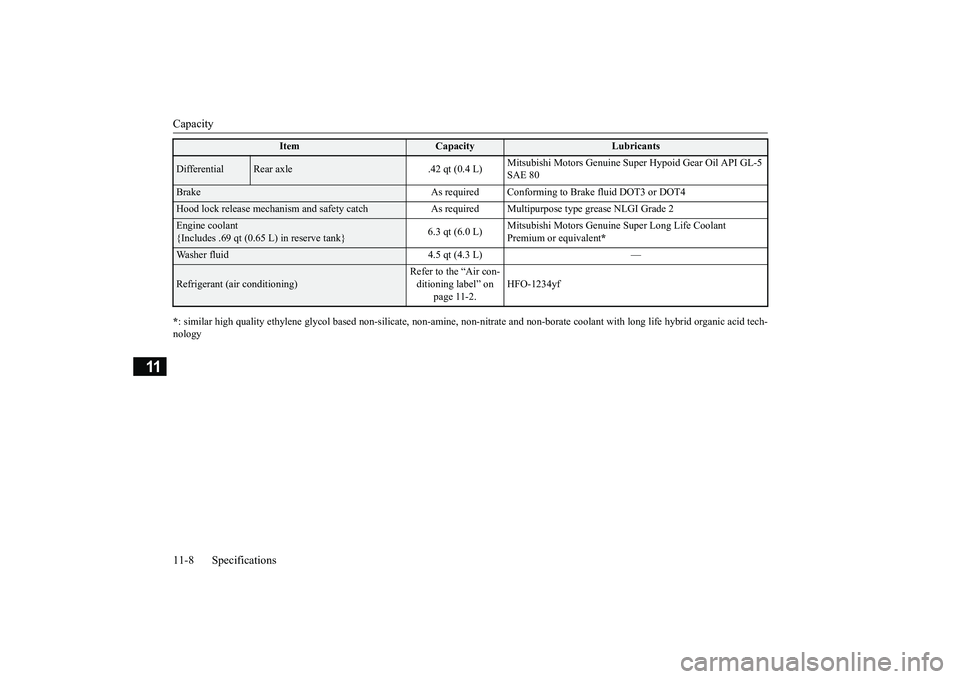
Capacity 11-8 Specifications
11
* : similar high quality ethylene glycol based non-silicate, non-am
ine, non-nitrate and non-borate
coolant with long life hybrid
organic acid tech-
nologyDifferential
Rear axle .42 qt (0.4 L)
Mitsubishi Motors Genuine Super Hypoid Gear Oil API GL-5 SAE 80
Brake As required Conforming to Brake fluid DOT3 or DOT4Hood lock release mechanism and safety catch As
required Multipurpose type grease NLGI Grade 2
Engine coolant {Includes .69 qt (0.65 L) in reserve tank}
6.3 qt (6.0 L)
Mitsubishi Motors Genuine Super Long Life Coolant Premium or equivalent
*
Washer fluid 4.5 qt (4.3 L) —Refrigerant (air conditioning)
Refer to the “Air con- ditioning label” on
page 11-2.
HFO-1234yf
Item
Capacity
Lubricants
BK0252700US.bo
ok 8 ページ 2017年10月4日 水曜日 午後4時54分